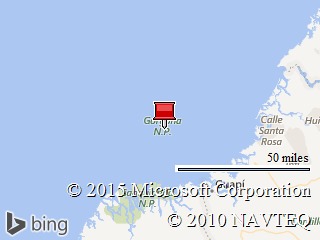Departing Bahia Solano yesterday afternoon, the Explorer cruised at a good clip in order to reach the isolated and little known island of Isla Gorgona. Before arriving, every passenger was issued a knee high pair of heavy rubber boots, and all we were told was that this was a requirement of the National Park Service for anyone going ashore.
Isla Gorgona is still in Columbia, and as our information sheet states, it “is an exotic destination by any standard.” The island is a UNESCO World Heritage Site and a National Natural Reservation Park. It is covered in lush tropical foliage and forests. Located only 35nm off the Columbian coast, it is also a good stopping off point for drug smugglers, which accounts for the presence of heavily armed police units; in fact, during our visit we were escorted by an armed officer. The island is 9 km long by 2.5 km wide. In 1959, the island was turned into a large maximum prison facility, similar to Alcatraz or Devil’s Island. The prison was closed in 1984.
This morning we were in the first group to go ashore for a wet landing onto a pebble beach, and from there were escorted to a small room to be briefed on our visit. There were a number of buildings in the compound, mostly now for the housing of Park officials and for the Police units. Until 4 weeks ago many of these buildings were part of a resort which was operated under contract with the Park service. The private contractor abruptly closed the facility down and left the island.
During our short briefing about the island, its history and current status, it became apparent that the knee high rubber boots were to protect against snakes. It seems that the one thing the island is famous for is the large diverse snake population including the Boa Constrictor.
From our small meeting room, we set out to visit the old prison. The temperature was moderate because of the overcast skies, however, the humidity was bloody awful. Our cameras, having come out of the air conditioned ship, were frosted over with condensation, and therefore useless until they adjusted to the temperature change. We are very familiar with the problem, and for that reason try to warm our cameras outside in plastic bags before going ashore, however, the humidity was so high, that even that trick alone did not solve the problem.
The prison tour was depressing, and wet. Moisture dripped from the dense foliage, and I can scarcely imagine a more depressing place to have to be imprisoned. We got some pictures, but the lack of light in the dense jungle made getting good photographs difficult.
By the way, did I mention snakes? I figured that on the trail the chances of actually seeing one would be small – WRONG. Someone yelled out, and not four feet from where we were was a large Boa working its way along the jungle floor. It was disturbed by our presence and so started moving away, but I did get some photos of this magnificent creature although they are not too good.
In our journey south along the Pacific coast of South America, we have now crossed over the equator, thus necessitating an appropriate ceremony with King Neptune. What an ordeal for first timers who are crossing the equator! Butter was smeared all over each one’s face; then wiped off with a pirate’s knife blade while forcing the person to kiss a long, dead fish; and finally having them drink some purple or green concoction. There were quite a number of guests who went through this process all the while having a good time.
That will bring this day to a close and tomorrow should bring us into Manta, Ecuador.
Jim




No comments:
Post a Comment